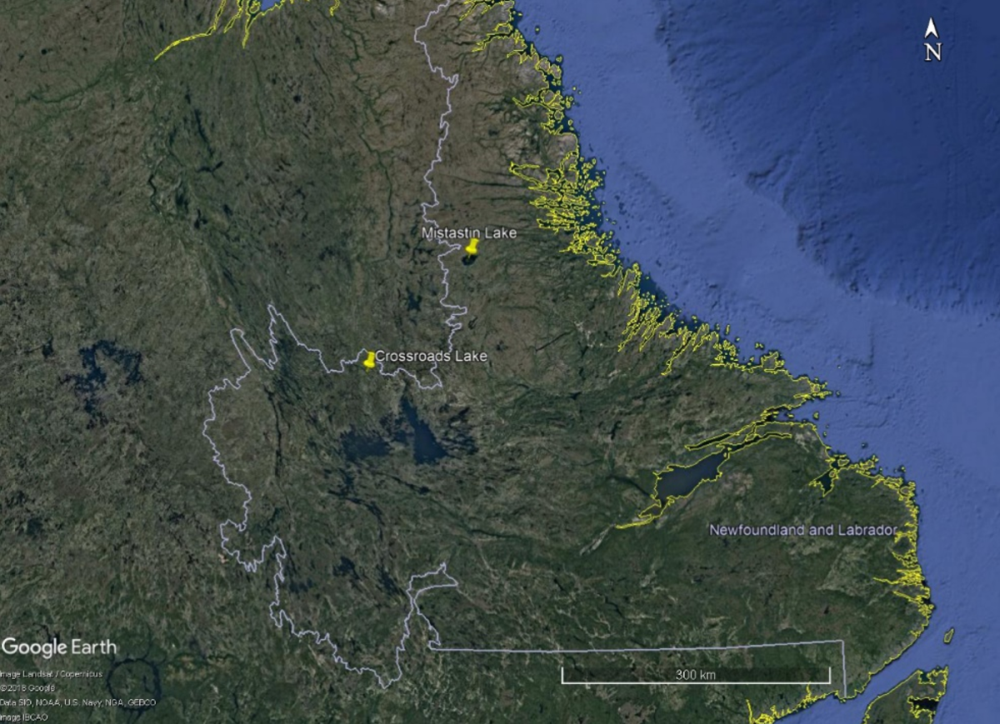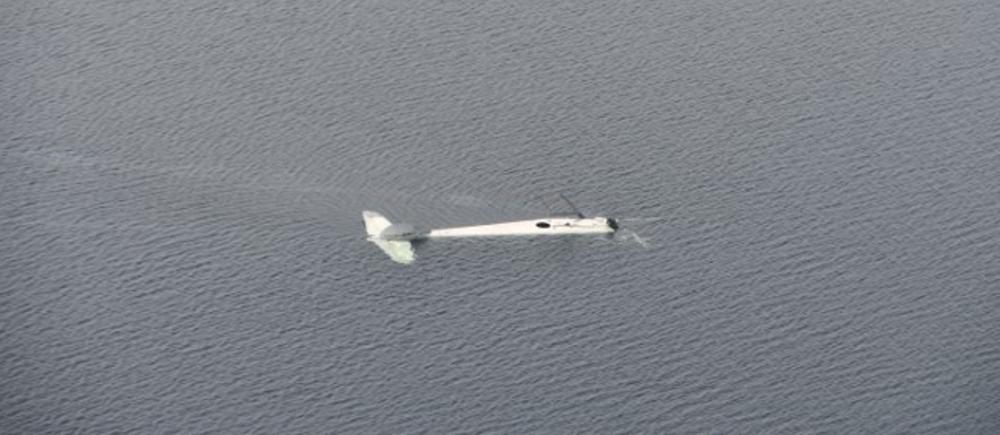Collision with water
DHC-2 Beaver float plane
Mistastin Lake, Newfoundland and Labrador
History of the flight
On , the float-equipped de Havilland DHC-2 MK I Beaver aircraft (registration C-FJKI, serial number 992), operated by Air Saguenay (1980) Inc. (Air Saguenay), was conducting a day trip under visual flight rules from a fly-in fishing lodge on Crossroads Lake, Newfoundland and Labrador, to Mistastin Lake, Newfoundland and Labrador. A pilot and 6 passengers were on board. The purpose of the flight was to travel to Mistastin Lake for a day of fishing. Mistastin Lake is approximately 16 km by 11 km in area and over 200 feet deep in places, and is accessible only by air.
There was some fog and mist in the morning, and the flight was delayed leaving the lodge, departing between 0900 and 0930.Footnote 1
When the aircraft did not return to the lodge in the evening, staff attempted to communicate with the aircraft through a radio at the lodge, and also through Air Saguenay's dispatch in Wabush, Quebec. When no communication was established, the company implemented its emergency procedure and first contacted the Joint Rescue Coordination Centre (JRCC) in Trenton at 2038. A search and rescue effort was initiated.
Search efforts
Once JRCC was contacted, a military search and rescue (SAR) aircraft was dispatched from Greenwood, Nova Scotia, which arrived over Mistastin Lake at around 0200 on 16 July. At around 0500, the SAR aircraft spotted the occurrence aircraft's fuselage floating in the water. Throughout the day, more SAR aircraft, both fixed wing and helicopter, as well as a contracted aircraft, conducted searches in the area for survivors. The bodies of 3 passengers were recovered from the water, the temperature of which was 6 °C to 7 °C. The search continued until around 2100, when the last helicopter departed from the scene.
On 17 July, the RCMP (Royal Canadian Mounted Police) recovery team organized the logistics of transporting personnel and equipment to the site due to its remote location.
On 18 July, the recovery team was unable to travel to the occurrence site because of poor weather.
On 19 July, when the recovery team arrived on site, the wreckage was no longer visible on the surface of the water. In the following weeks, extensive efforts by the RCMP, later assisted by the military, were conducted to locate and retrieve the other 4 occupants. On 24 July, the body of a fourth passenger was recovered.
None of the 4 passengers were found wearing personal flotation devices.
The search ended on 08 August 2019. The recovery team did not locate the remaining occupants or the wreckage. The pilot and the 2 other passengers are still missing. The RCMP continues to fly over the area when possible.
Aircraft information
The DHC-2 Beaver is type certificated for a maximum of 8 occupants: 2 in the front, 3 in the centre, and 3 in the rear. The occurrence aircraft was configured for 7 occupants, with the rear seat seating 2.
No anomalies were noted in a review of the aircraft's maintenance records.
The aircraft was equipped with a 406 MHz emergency locator transmitter; however, no emergency locator transmitter signal was received.
Pilot information
Records indicate that the pilot was certified and qualified for the flight in accordance with existing regulations. He held a commercial pilot licence (fixed wing and helicopter) and had accumulated over 18 800 hours of flying experience, with over 16 000 hours on DHC-2 aircraft. The pilot held a valid Category 1 medical certificate, last completed in May 2019.
The pilot was hired by Air Saguenay in 2011. He completed the annual required company training, including recurrent annual flight training. The pilot had often flown the route from the lodge to Mistastin Lake.
Wreckage information
The wreckage observed floating on the water during the first day of recovery consisted of the fuselage and empennage of the aircraft. When first discovered, the fuselage was inverted and partially submerged. The engine, wings, and floats had detached from the fuselage and were not visible.
Weather information
There is no weather station on Mistastin Lake. The nearest weather station to Mistastin Lake is in Nain, Newfoundland and Labrador, located about 75 nautical miles to the east of the lake. Nain is located on the Atlantic coast, which can affect its weather and thus its weather reporting may not be reflective of weather inland.
The weather in Nain throughout the day was light winds, visibility of 15 statute miles (SM), a few clouds at 1000 feet above ground level (AGL) that dissipated in the morning, and a broken ceiling of around 2000 feet AGL for the majority of the day.
According to the graphic area forecast (GFA)Footnote 2, at 0900, the area surrounding northern Labrador was forecasted to have overcast layers between 3000 and 18 000 feet AGL and greater than 6 SM visibility, with isolated altocumulus castellanus at 22 000 feet and 5 SM in light rain showers, mist, ceilings 800 feet AGL, and patchy ceilings 500 feet to 1000 feet AGL. At 1500, the forecast for the area was similar except that the isolated altocumulus castellanus areas would encounter ceilings at 1200 feet AGL. The 2100 GFA was similar to the 1500 GFA.
Next steps
The aircraft had been seen floating in Mistastin Lake and later sank. To date, the wreckage has not been found. There is no radar coverage at low altitudes in the area, and the aircraft was flying in uncontrolled airspace and not in communication with air traffic services. Without any witnesses and without key pieces of the aircraft, the TSB is unable to conduct a full investigation into this accident. If the aircraft is found, the TSB will assess the feasibility of investigating the accident further.
Media materials
Deployment notice
TSB will deploy a team following a seaplane accident in Mistastin Lake, Newfoundland and Labrador
Dartmouth, Nova Scotia, 16 July 2019 – — The Transportation Safety Board of Canada (TSB) will deploy a team of investigators to Mistastin Lake, Newfoundland and Labrador, where a de Havilland DHC-2 Beaver seaplane operated by Air Saguenay was involved in an accident. The TSB will gather information and assess the occurrence.
Class of investigation
This is a class 5 investigation. Class 5 investigations are limited to collecting data, which are then stored in the modal database. If TSB investigators deployed to the occurrence site, a short description of the occurrence is posted to the TSB website once the investigation has been completed. These investigations are generally completed within 90 days. For more information, see the Policy on Occurrence Classification.
TSB investigation process
There are 3 phases to a TSB investigation
- Field phase: a team of investigators examines the occurrence site and wreckage, interviews witnesses and collects pertinent information.
- Examination and analysis phase: the TSB reviews pertinent records, tests components of the wreckage in the lab, determines the sequence of events and identifies safety deficiencies. When safety deficiencies are suspected or confirmed, the TSB advises the appropriate authority without waiting until publication of the final report.
- Report phase: a confidential draft report is approved by the Board and sent to persons and corporations who are directly concerned by the report. They then have the opportunity to dispute or correct information they believe to be incorrect. The Board considers all representations before approving the final report, which is subsequently released to the public.
For more information, see our Investigation process page.
The TSB is an independent agency that investigates air, marine, pipeline, and rail transportation occurrences. Its sole aim is the advancement of transportation safety. It is not the function of the Board to assign fault or determine civil or criminal liability.

